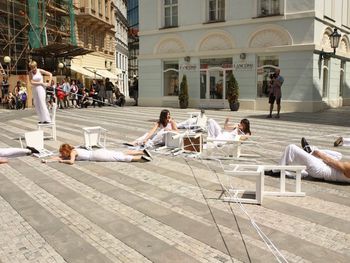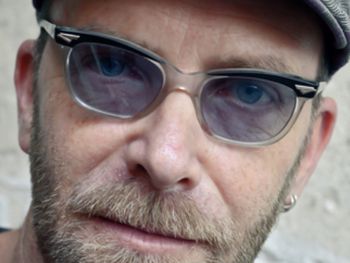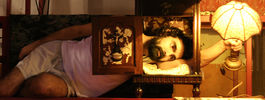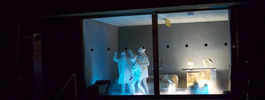In the past four years, a series of events, either accidental or planned, brought a major movement in terms of theatre and performance spaces in Cyprus. Theatre companies relocated either because plans for new facilities were finally realized or because of abrupt changes of plans brought on by major disasters, such as fires, storms, collapses or owners‘ decisions for change of use. Four new theatres have been and are in the process of being built, including the State Theatre and a grand-scale cultural centre. Not all the changes are of big scale, as at the same time small theatre spaces are being born, either within the texture of a historically significant building or following the new trends of the white cube. Small independent theatre groups sprout and, despite all the difficulties, plant the seeds for offering a platform for young voices to express themselves.
When thinking of theatre, there is something extremely interesting to be noted about shifting points, about the process by which a new trend begins to formulate, a different expression starts to be formed and a diversion leads the way from what ‘was’ to what ‘shall be’. New theatre groups need new spaces, and newborn spaces need alternative proposals. Therefore, the rebirth of spaces is closely linked with the rebirth of activity and creativity.
By focusing both on specific spaces that have experienced an important “shifting process” and on recent activities within them, we ask the questions: How can the history/biography/past life of a space (theatre, alternative space, transformed space or urban space) be thought of in relation to the performance it is hosting? What are the connections, influences and references that link the space with the performance design and its narrative content? How can scenography be perceived and influenced within the urban space? In some of the cases presented, the links are directly apparent; in others these connections might not be immediate or obvious (contemporaneous) but more of an abstract link.
If we consider the capital city of Cyprus, Nicosia, it is a fact that the city is undergoing important political, geographical and social changes.
The idea of the reunification of the north and south part of the island under a different constitution is the strongest concern, one that affects the divided capital directly. Borders are being opened and passages are being created in place of UN dead-ends, while large numbers of immigrant groups are changing the character of city areas. This urban arena, a constantly shifting space, could be perceived as an urban scenography. This is exactly where small independent spaces are inviting groups and individuals to find a voice, and where the practice of art is in a state of flux. The shifting point is a bridge between contrasting realities as it is manifested either in urban spaces or on theatre stages.
The Cyprus curatorial team will thus focus on the idea of the “shifting time and space” through specific tensions: construction vs. destruction, established places vs. urban ready-mades, textures as historical traces vs. the aesthetic of the clinically new. The notion of creation within an ambiguous state will be demonstrated through the common ground shared by the works of the presented scenographers, performance artists, sound designers and other artists, as well as the kinds of plays that are chosen. A separate section within the pavilion, called “Urban Ready-Mades” will be presented, focusing on hybrid scenography, city interventions, public performances and individual initiatives.
The idea behind the design of the Cyprus national pavilion is based in the process of “moving”, “relocating”, “transporting” from one place to another, even “relocating” or “reallocating”. The recent construction and distruction of several theatrical spaces in Cyprus mentioned before, as well as the use of urban spaces as stage areas, lead to a design that suggests an accumulation of objects, furniture, theatrical props and archives, packed and stacked. An installation of objects, a library of works, a game of discovery, a teaser of dimensions, a cabinet of curiosity, an exposition of works, an interactive world, a sense of mobility and spatial transformation.
The Cyprus participation questions the relationship between spaces/stages that have undergone experienced a transformation or have undergone a change of use, a change of activity, that demonstrate a sense of freedom, of expectancy. The space of possibility, of expectation, moving from “what was” to “what will be“.
- Άντης Παρτζίλης (Andy Bargilly)
* 1947, Famagusta
Specialization: art manager, teacher, set designer, costume designer, scenographer
Education: Stage and costume design at the Theatre Academy of Prague (DAMU), under professors František Tröster and Ladislav Vychodil
Collaboration with theatres: THOC
Participation in other important exhibitions: Gallery Exhibition of the inaugural World Stage Design Exhibition in Toronto ("The Phoenician Women", Euripides) and Gallery Exhibition of the World Stage Design Exhibition in Seoul ("Sirens", Antonio Colandrea; "Iphigenia in Tauris", Euripides)
Additional information: Andy Bargilly is the founder and president of the Cyprus Centre of Scenographers, Theatre Architects and Technicians (member of OISTAT), and spent 13 years as the director of THOC (State Theatre). He is also the co-founder and first artistic director of the Skala Theatre in Larnaca, Cyprus. Bargilly was the commissary for the Cypriot entry for PQ'91 and PQ'99, and an exhibitor at PQ'95 and PQ'03. He designed the Cyprus pavilion for PQ'07.
Bargilly has designed sets, costumes and posters for more than 100 productions for theatre, ballet, opera, television and cinema in Cyprus, Greece and Germany. He received the THOC Theatre Award for outstanding stage design in 1999-2001 for the production of “Seven Against Thebes”, as well as the 2009 Special Award of the 5th Cyprus Short Film Festival for best art direction for the film “Oedipus”.
He exhibited at PQ in 1991 and 1995.
Exhibiting works
-
Max Frisch: Ο Μπίντερμαν και οι εμπρηστές (The Fire Raisers),
Θέατρο ΣΚΑΛΑ
(SKALA Theatre),
2008, Director: Andreas Melekis, Costume and set design by Andy Bargilly ; Identification of exhibit:
model , photo
- Μελίτα Κούτα (Melita Couta)
Specialization: set designer, costume designer, sculptor, scenographer
Education: MA Fine Arts, Sculpture, Slade School of Art, London. BA Fine Arts, Sculpture, Central St Martin's, London
Collaboration with theatres: Cyprus Theatre Organisation (THOC)
Teaching activities: Teaching Studio Art at Frederic Institute of Technology, Nicosia, Cyprus
Participation in other important exhibitions: OPENASIA Venice 04, Cairo Biennale 03, Sarajevo Biennale of young artists, 100 ARTISTS FOR A MUSEUM, Italy, SOMATOPIA UK
Continuing collaboration with directors: Kyperská divadelní organizace (THOC)
Additional information: Cofounder of PARAVAN PROACTIONS dealing with creative site specific theatre, creative design and experimental projects. Co-curator of STI BOUKA, a retrospective of scenography.
Exhibiting works
-
-: Που και αυτό σπίτι μου είναι (Which is Also My Home),
-
(-),
0 Creator/Performer: Marios Ioannou ; Identification of exhibit:
costume
- Harris Kafkarides
Specialization: set designer, costume designer, scenographer, Epi Skinis Magazine for the Arts and Theatre, art director and designer
Education: BΑ in theatre design for performance, MA in scenography, Central St. Martins College of Art and Design, London
Collaboration with theatres: THOC (National Theatre), Satiriko Theatro, ETHAL, Paravan Proactions
Teaching activities: Scenography for drama students at Vladimiros Kafkaridis Drama School
Participation in other important exhibitions: Young Scenographers Exhibition, 2002, National Theatre of Greece; "Stin Bouka" scenography exhibition, Nicosia (2007)
Additional information: THOC Theatre Award 2003-2005 for the stage design of "The House" by M. Pieris. Best Costume Design Award 2005-2007 from THOC Theatre Awards. Curator of the 2006 “Stin Mpouka” scenography exhibition in Nicosia. Curator of the THOC exhibition "25 Years in Epidavros", Athens, Greece. Co-founder of Nicosia-based Paravan Proactions Experimental Theatre Company.
Exhibiting works
-
Akis Dimou: Απόψε τρώμε στης Ιοκάστης (Tonight we Dine at Jokasta's),
Σατιρικό Θέατρο
(Satiriko Theatre),
2009, Director: Despina Bebedeli, Set and Costume Designer: Harris Kafkarides ; Identification of exhibit:
model ;
Comments: The play is a comedy with farcical elements, a crazy social satire parodying the industry of "family" television series - "A pop family story" is the humorous subtitle of the play. The play is based on memories of the innocent nutty families from old Greek movies, except that the era of innocense has passed and now the cynicism and kitsch or our senseless era are the rule, where everything has changed and only feelings remain the same.
-
Lukas Bärfuss: Οι σεξουαλικές νευρώσεις των γονιών μας (The Sexual Neuroses of Our Parents),
Θεατρικός Οργανισμός Κύπρου
(Cyprus Theatre Organisation),
2010, Director: Yiannis Paraskevopoulos, Scenography: Harris Kafkarides
Light designer: Giorgos Lazoglou
Video art: Nicoleta Kalatha ; Identification of exhibit:
photo
- Καρολίνα Σπύρου (Karolina Spyrou)
Specialization: lighting designer, scenographer
Education: BA in theatre and performance design (1st Class Honours) from Liverpool Institute of Performing Arts; foundation course in art and design (with distinction) at LEDRI School of Art and Design, Nicosia/Cyprus
Collaboration with theatres: Ethal, Alpha Square, Solo for Three, Rialto Theatre, Rooftop Theatre Group, Aigaia Theatre, Xmas Productions
Additional information: Karolina Spyrou has worked on many projects as a lighting designer, including dance, concerts and fashion shows (Theatre Month at the National Theatre of Northern Greece; Danceunion; South Bank Centre, London; Hellenic Festival, Greece; Euro-Scene 14 Festival, Leipzig/Germany)
Exhibiting works
-
Henrik Ibsen: Βρυκόλακες (Ghosts),
Θεατρικός Οργανισμός Κύπρου
(Cyprus Theatre Organisation),
2008, Director: Yiannis Iordanides, Set and costume design: Stavros Antonopoulos
Light design: Karolina Spyrou ; Identification of exhibit:
photo
- Άγγελος Αγγελή (Angelos Angeli)
Specialization: teacher, set designer, costume designer, scenographer
Education: Studied scenography and costume design at the School of Fine Arts in Florence and at the School of Scenography Τeatro Alla Scala of Milan
Collaboration with theatres: THOC, Theatro Askisi
Teaching activities: Taught in public high schools in Cyprus, ANT1 Schools in Athens, as well as at various theatre schools in Athens.
Participation in other important exhibitions: Expo '92 Seville
Additional information: Angelos Angeli has collaborated with Ronconi, Zefireli and Damiani on opera and ballet productions. He designed the Gianni Versace costumes for Maurice Bejart's ballet performance "Dionysous" at the Skala in Milan. Angeli has created the scenery and costumes for more than 150 works of theatre, opera and cinema, with a specialization in ancient drama.
Exhibiting works
-
Thomas Vinterberg, Mögens Rukov, Bo. Hr. Hansen. Adapted for the english stage by David Eldridge, Greek translation by Aliki Danezi Knutsen and Manolis Dounias: Festen (Festen),
Θεατρικός Οργανισμός Κύπρου
(Cyprus Theatre Organisation),
2009, Director: Neophytos Taliotis, Scenography: Angelos Angeli
Light Design: Giorgos Koukoumas ; Identification of exhibit:
photo, DVD
- Έλενα Κατσούρη (Elena Katsouri)
* 1972, Nicosia
Specialization: set designer, costume designer
Education: Theatre design, University of Central England, Institute of Art and Design
Collaboration with theatres: THOC, Theatro ENA, ETHAL, Open Theatre, Antidote Theatre, Dionysos Theatre, Rooftop Theatre, Fantastiko Theatro
Participation in other important exhibitions: World Stage Design Exhibition 2013, Cardiff Wales, 'Sti Mpouka' scenery exhibition, Nicosia/Cyprus (2007); Scenic & Costume Exhibition, Evagoras Lanitis Centre, Limassol/Cyprus (2008)
Continuing collaboration with directors: Evis Gabrielides, Stephanos Kotsikos, Minas Tingilis, Yiannis Rigas, Magdalena Zira, Kyriaki Malama, Sarah Norman, Varnavas Kyriazis, Lea Maleni
Additional information: Cyprus Theatre Organization Award for Best Scenography 2007-2009 for 'The Glass Menagerie'; participation in masterclasses with Ralph Koltai. Costume design for main event of 50th anniversary celebrations of the Republic of Cyprus.
Exhibiting works
-
Joanna Murray-Smith: Όνορ (Honor),
Θέατρο ΔΙΟΝΥΣΟΣ
(Dionysos Theatre),
2008, Director: Stephanos Kotsikos, Set and costume design by Elena Katsouri ; Identification of exhibit:
model , photo
- Εδουάρδος Γεωργίου (Edouard Georgiou)
* 1968, Limassol
Specialization: architect, set designer, costume designer, scenographer
Education: Architecture, National Technical University of Athens; Scenography, Ecole d’Architecture de Clermont Ferrand, France
Collaboration with theatres: THOC-National Theatre/Cyprus, ETHAL/Lemesos Subsidized Theatre/Cyprus
Additional information: Edouard Georgiou has worked with Thessaloniki’s Art Theatre, DIPETheatre of Agrinio in Greece, ETHAL-Cyprus theatre of Lemesos and THOC-Cyprus Theatre Organisation in Cyprus. From 2002 to 2009, he was the scenographer for the PANDOUM Street Theatre Company. In 2008 he received the Cyprus State Theatre Award for his scenography for the ETHAL production of "Pinder’s Homecoming". He is a founding member of the Greek Theatre Designers Association.
Exhibiting works
-
Azis Nesin: Άντε ψυχούλα μου, σκότωσέ με! (Come, My Soul, Kill Me!),
Εταιρεία Θεατρικής Ανάπτυξης Λεμεσού
(ETHAL),
2008, Director: Costas Demetriou, Scenographer: Edouard Georgiou ; Identification of exhibit:
photo, collage
- Αντώνης Αντωνίου (Antonis Antoniou)
* 27.08.1978, Cyprus
Specialization: composer, teacher, sound designer
Education: BA in music, MA in music composition (grant awarded), PhD candidate at Goldsmiths University of London; BA in music composition, Thames Valley University London; jazz course at Philippos Nakas Conservatory, Athens; BA in business administra
Collaboration with theatres: THOC, Satiriko, Paraplevros Paragoges
Teaching activities: Workshops in 2010 atCyprus University of Technology, University of Nicosia, Artos Foundation. Artos Foundation workshop. Classical guitar and theory of music private teaching, 2009-present
Participation in other important exhibitions: Amsterdam Biennale 2010; Rainforest 4 at Area10, London 2009; "Koitazontas loksa ta peninta hronia tis Kypriakis Dimokratias", Limassol/Cyprus (2010); "Chypre 2010 L'art au present", Paris (2010)
Additional information: The soundscape composition "Soundscape Nicosia" has been broadcast by various international art radio stations, including London's "Resonance FM" art radio station, “SoundArt” radio in Devon, CKUT radio in Montreal, “Radio Zero” in Lisbon and “RadioCampus” in Brussels.
Exhibiting works
-
Antonis Antoniou: RainZonanceS (RainZonanceS),
-
2010, Director: Antonis Antoniou, Lights: Evripides Dikaios
Installations: Paravan ; Identification of exhibit:
DVD , sound ;
Comments: RainZonanceS… "…augmenting the aural personality of unusual spaces…stretching the awareness of the sonic activity and sonic memory formed within physical boundaries… irritating the walls' resonance frequencies…boosting spatial experience…"
Inspired by David Tudor’s milestone piece ‘Rainforest IV’, this ongoing project aims to expose the experiential attributes of unusual spaces by using primarily sound and light. Each space has its own aural architecture and responds to our actions in a specific manner; it has the inherent ability to affect our feelings and moods; it is a ‘sponge’ of past voices, gestures and utterances. ‘RainZonanceS’ juggles with these realities. It brings out the texture, colour, tone and emotion found in extraordinary spaces; spaces of special interest, of unique character. It takes their atypical characteristics to their extremes. ....
This second project by RainZonanceS takes place at the old Satyriko Theatre, the former Adelfi Varnakidi cinema, a building that is scheduled to be demolished in the near future. The audience is invited to experience a last show in this full-of-energy space; to move around the building and use it in a different way, to watch and listen to the voices and shadows of the past. “Monologue, film, dialogue, singing, anger, black and white, coloured, tragedy, comedy, laughter, sigh, weep, surprise, sit, stand, brake, eat, pop corn, foyer, ticket, soundtrack, playback, curtain, stage, scene, script, rehearsal”…gestures, moods and actions absorbed by the walls of the building and by the people who spent time in it. When squeezed, a sponge full of multi-colour paints releases a fusion of colour and texture. The element of time alters the quality of this amalgam even more, adding noise, grain and perhaps a sort of emotion. This site-specific project aims to retrieve the absorbed energy that exists within the walls of the building, to squeeze the sponge of past sonic activity, to capture ghosts and shadows, to resonate with the shaped echoes, and portray it in a somewhat abstract manner. ....
Some of the methods/techniques/material used for the realisation of this portrait are: random procedures, audiovisual material from past selected plays at the theatre, generative surround composition, compositions in mono format presented as sound installations, domestic lighting, projections of found objects, shadow activation of found objects, live electronics, text and utterance performance and improvisation...
- Λάκης Γενεθλής (Lakis Yenethlis)
Nicosia, Cyprus
Specialization: set designer, costume designer, scenographer
Education: Art and design, Middlesex University; theatre design, Central St Martin's School of Art and Design
Collaboration with theatres: THOC, Theatro Skala
Awards: Linbory Price at the Royal National Theatre in 1993
Additional information: THOC Awards: Best Costume Designer Award (2001), Best Designer (2003), Best Costume Designer (2009). Currently lives in Cyprus and works extensively in the field of film and television.
Exhibiting works
-
Costas Montis: Απαγορεύεται η είσοδος στο Άγχος! (Entrance Forbidden to Stress!),
Θέατρο Επίγονοι
(Epigonoi Theatre),
2007, Director: Photos Photiades, Scenography: Lakis Yenethlis ; Identification of exhibit:
model
- Σταύρος Αντωνόπουλος (Stavros Antonopoulos)
* 1962, Nicosia
Specialization: set designer, costume designer, painter , scenographer
Education: Studied painting at the Florence Academy of Fine Arts (1981-1985); fashion design at Scuola Magda de Lazzari, Florence/Italy (1982-1984); and scenography at Sorbonne University, Paris/France (1988-1990)
Collaboration with theatres: THOC
Participation in other important exhibitions: Mediterranean Strokes, USA (2009); Cypriot Artists, Norway (2009); The Odyssey Within, USA (2008); 5 Contemporary Cypriot Artists, Germany (1987); Contemporary Cypriot Art, London (1991); Biennale of Alexandria (1994); Biennale of Young Artists, France (1
Awards: Premio Internazionale d’Arte Moderna, Florence/Italy (1987); Prix Matisse, French Embassy, Nicosia (1987)
Additional information: Freelance stage and costume designer. He graduated from the Academy of Fine Arts in Florence and from the Sorbonne University in Paris. Currently co-operates with Cyprus Theatre Organisation (State Theatre) and Teatro Ena as a stage and costume designer. In 1987, he received the Premio Internationale ďArte Moderna in Florence and Prix "Matisse" from the French Government.
Exhibiting works
-
Henrik Ibsen: Βρικόλακες (Ghosts),
Θεατρικός Οργανισμός Κύπρου
(Cyprus Theater Organisation),
2008, Director: Yiannis Iordanides, Set and Costume Designer: Stavros Antonopoulos
Light Designer: Karolina Spyrou ; Identification of exhibit:
model , photo
- Στυλιανός Πελεκάνος (Stylianos Pelekanos)
* 08.09.1970, Nicosia
Specialization: architect, set designer, Industrial design, jewellery design
Education: Architecture School of Aristotelian University, Thessaloniki/Greece (Honors); master in architecture from the Bartlet School of the University College London
Additional information: Stylianos Pelekanos is a founding member and partner in Omass Architectural Office, which originally created designs for contemporary dance groups and later for selected theatre plays.
Exhibiting works
-
Harold Pinter: Ο Εραστής (The Lover),
Θέατρο ΣΚΑΛΑ
(Theatro Skala),
2008 Creation builder: Katerina Loura
Stage design: Stylianos Pelekanos ; Identification of exhibit:
photo
- Λέα Μαλένη (Lea Maleni)
Specialization: actor, theatre director, Worked for television as script writer, presenter and actress.From 1992 until 2003 worked on a regular basis with the Cyprus Broadcasting Corporation, producing and presenting musical and other programs.
Education: Drama School of the Greek National Theatre (Degree in Acting, 1993); Goldsmiths College, University of London (MA in Directing, 2004)
Collaboration with theatres: As an actress and stage director for THOC
Teaching activities: Taught acting at Vladimiros Kafkarides Drama School, Cyprus (2007-2009)
Awards: Nomination for best supporting part, Thessalonica Film Festival 2003
Additional information: Lea Maleni is the founder (in 2004) of Persona Theatre Company. THOC-Melina Mercouri Theatre Award Prize for Best Actress for 2001-2003 (Sarah Norman in "Children of a Lesser God"). Nominated for best director - THOC Theatre Awards 2003-5 ("Orlando") and THOC Theatre Awards 2005-2007 ("Laios' Murderer and the Crows"). International collaborations as director with the National Theatre of Greece, Experimental Stage in 2006 and Nowy Teatr in Poznan, Poland in 2010.
Exhibiting works
-
Devised Theatre (dramaturgic analysis of text: Antonis Georgiou, Lea Maleni, George Rodosthenous, Liza Tsaggaridou): ON/OFF (Life Cuts) (ON/OFF (Life Cuts)),
Θεατρικός Οργανισμός Κύπρου
(Cyprus Theatre Organisation),
2007, Director: Lea Maleni, Lea Maleni ; Identification of exhibit:
model , photo ;
Comments: Lea has been characterized as a Visual Art Stage Director, in the sense that even though her academic background does not include scenography, she incorporates visual art and space work in the conceptualization of her projects as a theatre director and actress.
- Γιώργος Κουκουμάς (Georgios Koukoumas)
Specialization: lighting designer, Film Director, Photographer
Education: BA 1993-1996. Studied at the Lykourgos Stavrakou Cinema and Television Academy in Athens, Greece
Collaboration with theatres: Worked as lighting technician with Satiriko Theatre (1990-92, 1995) and Theatro Skala (1996). Since 1997 he works as Lighting Technician in the Theatrical Organization of Cyprus. Since 2005, chief lighting technician at Cyprus Theatre Organisation.
Teaching activities: Chief Lighting Technician
Additional information: In 1997, Giorgos Koukoumas represented Cyprus at the Biennale of Young Artist in Torino/Italy with the photographic work “ Milo milo milo”. He has produced and directed the following short films: “Photograph No. 6” (2003), “You Will Find Him in Fairy Tales” (2005, adaptation of performance by the Antidote Theatre), “Τhe Fisherman” and “Actor” (2006, 5-minute biographical films), and “Helmets” (2009), which won Best Costumes (C.D Mariza Bargily) and Best Photography (D.P Nicos Abraamides) at the Drama Film Festival (2009).
In 2007 he was awarded the THOC Theatre Award for Light Design for the play "Diary of a Madman" by Nicolai Gogol.
Exhibiting works
-
Thomas Vinterberg, Mögens Rukov, Bo. Hr. Hansen. Adapted for the English stage by David Eldridge. Greek translation by Aliki Danezi Knutsen and Manolis Dounias: Festen (Festen),
Θεατρικός Οργανισμός Κύπρου
(Cyprus Theatre Organisation),
2009, Director: Neophytos Taliotis, Scenography: Angelos Angeli
Light Design: Giorgos Koukoumas
; Identification of exhibit:
photo, DVD
- Παύλος Σιδέρης (Pavlos Sideris)
* 21.05.1981
Specialization: architect, set designer
Education: Graduated with honours from the Architectural Association in London (2006). Has been working independently ever since.
Teaching activities: Pavlos has both taught and practiced in the UK and other countries, and has produced seminal work in the field of parametric form found design.
Participation in other important exhibitions: Design For The Other 90%, Cooper-Hewit National Design Museum, New York
Additional information: Pavlos Sideris is director of Kukan Architects, a team of young architects who seek to create opportunities while working with a wide range of buildings, products and techniques, from small to large.
Exhibiting works
-
kolektivní tvorba/devised play: Ο Καραγκιόζης Εκτός (Karagiozis Exposed),
Open Arts
(Open Arts),
2008, Director: Evripidis Dikaios, Athina Kasiou, Designer: Pavlos Sideris
Harris Bilinis: Construction of figures
Nikos Kostopoulos: Construction of set
Yiannis Hadjiantoniou: Light Designer (2008)
Marina Hadjilouca: Light Designer (2007) ; Identification of exhibit:
object, video
- Φάνος Κυριάκου (Phanos Kyriacou)
* 07.01.1977, Nicosia, Cyprus
Specialization: sculptor, Giant Midget
Education: MFA from Goldsmiths University, London (2006-2007); BA in fine arts from Middlesex School of Arts, London (1999-2001)
Participation in other important exhibitions: OPEN 13, International Exhibition of Sculptures & Installations, Lido, Venice; Chypre 2010, L'art au Present, Espace Commines, Paris/France; Sinergia, Aggelos Makrides and Phanos Kyriacou, Cyprus Archaeological Museum
Additional information: Phanos Kyriacou wrote:
I HATE THE COLOUR OF MY CANARY SO I DECIDED TO REPAINT MY CAGE
Exhibiting works
-
-: Crashed Helmets Must be Removed (Crashed Helmets Must be Removed),
Apotheke
(Apotheke),
2009 Phanos Kyriacou, concept, installation ; Identification of exhibit:
DVD
- MITOS Theatre Group -
Specialization: Theatre group specializing in research and performance
Additional information: MITOS Theatre Group
www.mitos.org.cy
MITOS is represented at PQ11 by the renovation recreation of its home stage, Palio Xydadiko (an old vinegar factory).
The MITOS Centre of Performing Arts is a non-profit organization created by performers Elena Agathokleous and Lukasz Walewski in 2007 in Lemesos, Cyprus.
The centre's main activity is the MITOS Theater Group, research and performance.
The company' work with ancient Greek drama - the source of traditions - and its search for contemporary approaches and experience led it to develop its own vocabulary of theatre art. The MITOS Theater Group's performances have been selected for international festivals as the official entry for Cyprus.
The MITOS Centre of Performing Arts also creates other artistic events, such as "A Little Festival", an international meeting about ancient drama, the "Strange Screen" experimental film festival, "Senses", an upcoming festival of performing arts, and other activities including exhibitions, installations, happenings, workshops, residences, exchanges and projections. The centre collaborates with and invites artists or teams from Cyprus and from abroad to present their works. There are also plans for the creation of an audiovisual archive and library.
The centre's "home" is Palio Xidadiko (an old vinegar factory), located in the historical part of Lemesos and with very interesting traditional architecture. The first building is dated to the late Middle Ages, and in the twentieth century it was home to a laboratory of traditional production - first cognac and later vinegar. The space was internally linked via archways with the neighbouring buildings, but by the time MITOS moved in in 2007, the area was limited to a mere 120 square metres.
The architecture, the energy and the amazing acoustics have changed Palio Xidadiko into a field of inexhaustible artistic choices and possibilities. The centre's activities take place concurrently with the building's progressive renovation. We have consciously maintained the philosophy of the empty space, so that each new production changes dramatically - as a space - following the character of the event.
Exhibiting works
-
-: Το παλιό ξυδάδικο (The Old Vinegar Factory),
ΜΙΤΟΣ
(MITOS),
0 Founders: Elena Agathokleous and Lukasz Walewski ; Identification of exhibit:
photo, DVD ;
Comments: MITOS Center of Performing Arts
1 Astiggos str., 3016 Lemesos Cyprus
mitos@mitos.org.cy
www.mitos.org.cy
Contact telephone 00357 99985232
MITOS Center of Performing Arts – Palio Xidadiko
The MITOS Centre of Performing Arts is a non-profit organization created by performers Elena Agathokleous and Lukasz Walewski in 2007 in Lemesos, Cyprus.
The centre's main activity is the MITOS Theater Group, research and performance.
The company' work with ancient Greek drama - the source of traditions - and its search for contemporary approaches and experience led it to develop its own vocabulary of theatre art. The MITOS Theater Group's performances have been selected for international festivals as the official entry for Cyprus.
The MITOS Centre of Performing Arts also creates other artistic events, such as "A Little Festival", an international meeting about ancient drama, the "Strange Screen" experimental film festival, "Senses", an upcoming festival of performing arts, and other activities including exhibitions, installations, happenings, workshops, residences, exchanges and projections. The centre collaborates with and invites artists or teams from Cyprus and from abroad to present their works. There are also plans for the creation of an audiovisual archive and library.
The centre's "home" is Palio Xidadiko (an old vinegar factory), located in the historical part of Lemesos and with very interesting traditional architecture. The first building is dated to the late Middle Ages, and in the twentieth century it was home to a laboratory of traditional production - first cognac and later vinegar. The space was internally linked via archways with the neighbouring buildings, but by the time MITOS moved in in 2007, the area was limited to a mere 120 square metres.
The architecture, the energy and the amazing acoustics have changed Palio Xidadiko into a field of inexhaustible artistic choices and possibilities. The centre's activities take place concurrently with the building's progressive renovation. We have consciously maintained the philosophy of the empty space, so that each new production changes dramatically - as a space - following the character of the event.
- Open Arts -
Specialization: Open Arts' aim is to promote the work of Cypriot artists at home and abroad by initiating international collaborations
Additional information: Open Arts was founded by Athina Kasiou in 2006 as a non-profit organisation active from both London and Nicosia. The aim of the organisation is to promote the work of Cypriot artists at home and abroad by initiating international collaborations.
For its first project, Open Arts produced Athol Fugard's "Sizwe Banzi is Dead", directed by Peter Brook and presented at Theatre Dionysos in Nicosia, Cyprus. This was the first time the work of Peter Brook was presented in Cyprus.
The company grew in 2007 with the addition of Cypriot and international artists for the creation of "Karagiozis Exposed", a contemporary take on the traditional shadow puppet tradition, co-directed by Athina Kasiou and Euripides Dikaios. Extracts of the show were presented at the Dogstock musical festival in Pomos in August 2007. The show premiered on the Experimental Stage of the National Theatre of Cyprus in September 2007 where it had a successful sold-out run.
The show has since toured around Europe, starting from a prime-time slot at Divaldo Ná Pradle, the main stage of the 2008 Prague Fringe Festival, then visiting Greece (Athens and mainland), and followed up by an exhaustive tour in the countryside and towns in Cyprus. The tour is now in its last stretch, playing at the Arcola Theatre in London.
Open Arts’ work has been supported by the Ministry of Culture and Education of Cyprus, the French Cultural Centre and the National Theatre of Cyprus.
- Fresh Target Theatre Ensemble -
Specialization: Fresh Target Theatre Ensamble is a group specializing in creating theatrical conditions in non-theatre environments, thus increasing audiences' and artists' freedom.
Additional information: Fresh Target Theatre Ensemble was created in 2008 by Paris Erotokritou and Yiannis Gavrielides. In their performances they aim for the use of non-theatrical spaces, within which they create a theatrical environment in which the spectators are not "fixed" to their seats but are free to walk, explore and discover. It is a theatrical environment in which theatre action is the base for a common experience between actors and spectators. The group's philosophy is to work both with new interesting groups that share common aims, but also with professionals who do not usually work with theatre (architects, visual artists, fine artists, sound engineers, etc). In the ensemble's view, such collaborations help the creative process and bring together various experiences with a common goal. A parallel aim of the group is to function as a link between Cypriot and Greek artists, and for Cypriot-Greek artists residing abroad, so as to realize theatre performances in Athens, Nicosia and London.
Exhibiting works
-
Harold Pinter: Ο Εραστής (The Lover),
Fresh Target Theatre Ensemble
(Fresh Target Theatre Ensemble),
2009, Director: Paris Erotokritou, Aris Kleanthous, Elena Antoniou, interior designer ; Identification of exhibit:
photo
- Apotheke -
Specialization: Apotheke is a dynamic, multi-disciplinary cultural institute, supporting and showcasing contemporary art, ideas and culture
Additional information: Over a 15-year period, Apotheke has hosted a wide range of groundbreaking art exhibitions, workshops, talks, ad-hoc residencies, free bars and pop-up recording studios, which have critically reflected on arts and culture. Radical from its inception, Apotheke is dedicated to introducing and promoting audacious attempts of contemporary artists, designers, theorists, writers, activists and others, in rigorous new frameworks and invigorating modalities.
Apotheke’s home has been an instrumental factor in all of its activities. Housed in a rare, small-scale industrial building on the back-streets of the walled part of the city of Nicosia, Apotheke has evolved alongside the broader network of innovative engagement with art and culture in and of the capital city of Cyprus as well. In coexistence with its acclaimed, international program, it has formed allegiances and relationships with a variety of individuals and collectives in Nicosia, and has played a substantial role in offsite projects ranging from the Nicosia Architectural Biennial to autonomist street festivals. As part of its passion and ethos for the city of Nicosia, Apotheke makes as much use as possible of workshops and the technical know-how found within the municipality of Nicosia.
Apotheke has also established numerous collaborations and working partnerships with international and local institutions, including Kunstverein Hamburg, NiMAC, Mediamatic, MitOst e.V., Tramba A.C., Transidency, the Undo Foundation and others, and has been represented at numerous art fora and fairs (Manifesta 6, Art Forum Berlin 2007, 11th Venice Biennial of Architecture, Tell A Story 2009, Amsterdam Biennial 2009, etc).
Exhibiting works
-
: (Apotheke),
Apotheke
(Apotheke),
0 Demetris Taliotis, Constantinos Taliotis, founders ; Identification of exhibit:
photo
- Paravan -
Additional information: ‘Paravan Proactions’ was created in January 2006 by Melita Couta and Harris Kafkarides. The aim of the group is to investigate contemporary, experimental methods of performance and visual arts through the exchange of ideas. The group, which has artistic creativity at its core, brings together artists from a variety of fields to produce original works through creative dialogue and exchange of ideas. Paravan emphasizes the visual aspect of theatrical performance and focuses on the creation of impressions, emotions and experiences through image, sound, movement and the use of multimedia. It also explores theatrical tools beyond the existing methods of scenography, though the use of technology and very basic material. Theatre productions include: ‘Zoo’ based on George Orwell’s ‘Animal Farm’ (May 2007) and A.Tzari’s ‘Ubu Roi’ (November 2008). Dance productions include ‘To queue is to Quake’ (2010, choreography by Pascal Caron). Exhibitions curated: ‘Stin Bouka, the visual aspect of theatrical creativity’, THOC scenography exhibition, Nicosia (2007) and THOC exhibition '20 Years in Epidavros', Athens/Greece
Text to the PQ'15 Catalogue:
The Paravan theatre group was established in 2006 by Melita Couta and Harris Kafkarides. They explore contemporary means of theatrical / visual expression through collaborations. Paravan specializes in site-specific theatre and performance installations.
Exhibiting works
-
: (The Basement),
Paravan Proactions
(Paravan Proactions),
0 Founders: Melita Couta, Harris Kafkarides ; Identification of exhibit:
photo, object
- Μαρίνα Μαλένη (Marina Maleni)
* 06.12.1967
Specialization: actor, theatre theoretician
Education: BA in theatre arts, BFA in acting, BA (honours) in sociology from University of Texas, Austin
Collaboration with theatres: Cyprus Theatre Organisation
Additional information: Marina Maleni is the curator for the Cyprus exhibition at PQ'11. She was also the curator for PQ '07.

















































